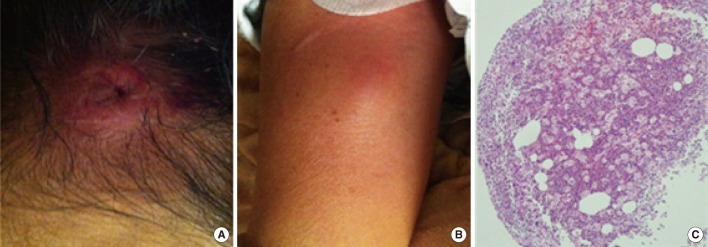Ann Lab Med.
2013 May;33(3):203-207. 10.3343/alm.2013.33.3.203.
The First Korean Case of Disseminated Mycetoma Caused by Nocardia pseudobrasiliensis in a Patient on Long-Term Corticosteroid Therapy for the Treatment of Microscopic Polyangiitis
- Affiliations
-
- 1Department of Laboratory Medicine, University of Ulsan College of Medicine and Asan Medical Center, Seoul, Korea. sung@amc.seoul.kr
- 2Department of Infectious Diseases, University of Ulsan College of Medicine and Asan Medical Center, Seoul, Korea.
- KMID: 1781328
- DOI: http://doi.org/10.3343/alm.2013.33.3.203
Abstract
- Nocardia pseudobrasiliensis is predominantly associated with invasive infections in immunocompromised patients. We report a case of disseminated mycetoma caused by N. pseudobrasiliensis in a 57-yr-old woman with microscopic polyangiitis, who was treated for 3 months with corticosteroids. The same organism was isolated from mycetoma cultures on the patient's scalp, right arm, and right leg. The phenotypic characteristics of the isolate were consistent with both Nocardia brasiliensis and N. pseudobrasiliensis, i.e., catalase and urease positivity, hydrolysis of esculin, gelatin, casein, hypoxanthine, and tyrosine, but no hydrolysis of xanthine. The isolate was identified as N. pseudobrasiliensis based on 16S rRNA and hsp65 gene sequencing. The patient was treated for 5 days with intravenous ampicillin/sulbactam, at which time both the mycetomas and fever had subsided and discharged on amoxicillin/clavulanate. This case highlights a very rare presentation of mainly cutaneous mycetoma caused by N. pseudobrasiliensis. This is the first reported case of N. pseudobrasiliensis infection in Korea.
MeSH Terms
-
Adrenal Cortex Hormones/*therapeutic use
Asian Continental Ancestry Group
Bacterial Proteins/chemistry/genetics
Female
Humans
Microscopic Polyangiitis/complications/*drug therapy
Middle Aged
Mycetoma/complications/*diagnosis/microbiology
Nocardia/genetics/*isolation & purification
RNA, Ribosomal, 16S/chemistry/genetics
Republic of Korea
Scalp/microbiology/pathology
Sequence Analysis, DNA
Skin/microbiology
Adrenal Cortex Hormones
Bacterial Proteins
RNA, Ribosomal, 16S
Figure
Reference
-
1. Wilson JW. Nocardiosis: updates and clinical overview. Mayo Clin Proc. 2012; 87:403–407. PMID: 22469352.
Article2. Ambrosioni J, Lew D, Garbino J. Nocardiosis: updated clinical review and experience at a tertiary center. Infection. 2010; 38:89–97. PMID: 20306281.
Article3. Heo ST, Ko KS, Kwon KT, Ryu SY, Bae IG, Oh WS, et al. The first case of catheter-related bloodstream infection caused by Nocardia farcinica. J Korean Med Sci. 2010; 25:1665–1668. PMID: 21060759.4. Moon JH, Cho WS, Kang HS, Kim JE. Nocardia brain abscess in a liver transplant recipient. J Korean Neurosurg Soc. 2011; 50:396–398. PMID: 22200027.5. Park BS, Park YJ, Kim YJ, Kang SW, Kim YH, Shin JH, et al. A case of disseminated Nocardia farcinica diagnosed through DNA sequencing in a kidney transplantation patient. Clin Nephrol. 2008; 70:542–545. PMID: 19049715.6. Ruimy R, Riegel P, Carlotti A, Boiron P, Bernardin G, Monteil H, et al. Nocardia pseudobrasiliensis sp. nov., a new species of Nocardia which groups bacterial strains previously identified as Nocardia brasiliensis and associated with invasive diseases. Int J Syst Bacteriol. 1996; 46:259–264. PMID: 8573505.7. Wallace RJ Jr, Brown BA, Blacklock Z, Ulrich R, Jost K, Brown JM, et al. New Nocardia taxon among isolates of Nocardia brasiliensis associated with invasive disease. J Clin Microbiol. 1995; 33:1528–1533. PMID: 7650180.8. Yin X, Liang S, Sun X, Luo S, Wang Z, Li R. Ocular nocardiosis: HSP65 gene sequencing for species identification of Nocardia spp. Am J Ophthalmol. 2007; 144:570–573. PMID: 17698022.9. Clinical and Laboratory Standard Institute. Interpretive criteria for identification of bacteria and fungi by DNA target sequencing; Approved guideline. MM18-A. 2008. Wayne, PA: Clinical and Laboratory Standards Institute.10. Clinical and Laboratory Standards Institute. Susceptibility testing of mycobacteria, nocardiae, and other actinomycetes; Approved Standard-Second Edition. M24-A2. 2011. Wayne, PA: Clinical and Laboratory Standards Institute.11. Kiska DL, Hicks K, Pettit DJ. Identification of medically relevant Nocardia species with an abbreviated battery of tests. J Clin Microbiol. 2002; 40:1346–1351. PMID: 11923355.12. Brown BA, Lopes JO, Wilson RW, Costa JM, de Vargas AC, Alves SH, et al. Disseminated Nocardia pseudobrasiliensis infection in a patient with AIDS in Brazil. Clin Infect Dis. 1999; 28:144–145. PMID: 10028089.13. Kageyama A, Sato H, Nagata M, Yazawa K, Katsu M, Mikami Y, et al. First human case of nocardiosis caused by Nocardia pseudobrasiliensis in Japan. Mycopathologia. 2002; 156:187–192. PMID: 12749583.14. Lebeaux D, Lanternier F, Degand N, Catherinot E, Podglajen I, Rubio MT, et al. Nocardia pseudobrasiliensis as an emerging cause of opportunistic infection after allogeneic hematopoietic stem cell transplantation. J Clin Microbiol. 2010; 48:656–659. PMID: 19940053.15. Mongkolrattanothai K, Ramakrishnan S, Zagardo M, Gray B. Ventriculitis and choroid plexitis caused by multidrug-resistant Nocardia pseudobrasiliensis. Pediatr Infect Dis J. 2008; 27:666–668. PMID: 18520971.16. Brown-Elliott BA, Brown JM, Conville PS, Wallace RJ Jr. Clinical and laboratory features of the Nocardia spp. based on current molecular taxonomy. Clin Microbiol Rev. 2006; 19:259–282. PMID: 16614249.17. Versalovic J, editor. Manual of clinical microbiology. 2011. 10th ed. Washington, DC: ASM Press.
- Full Text Links
- Actions
-
Cited
- CITED
-
- Close
- Share
- Similar articles
-
- Nocardia asteroides complex Isolated from Cerebrospinal Fluid and Surgical Wound Site: Three Case Reports
- A Case of Nocardia farcinica Brain Abscess in a Focal Segmental Glomerulosclerosis Patient after Steroid Treatment
- A Case of Microscopic Polyangiitis
- A Case of Disseminated Nocardiosis by Nocardia brasiliensis after Steroid Injection
- Pulmonary Nocardiosis Diagnosed by Fine Needle Aspiration: A Case Report



